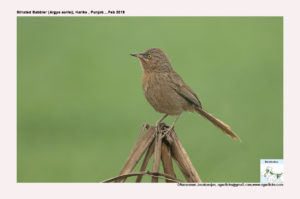
Striated babbler Turdoides earei
Etymology:
- Turdoides: Latin word turdus- thrush; Greek word oides –resembling { Resembling Thrush}
- Earlei : Ornithologist Willis Earle (fl. 1855)
Vernacular Names: Sind: Lelo, Hindi: Bada-phenga/genga, Chilchil, Pun: Dharidar serhari, Ben: Dora chhatare
Distribution in India: Resident of plains of North and North East India.
Description: Size of 24–25 cm; Wt. of 46–48 g. It is a long-tailed, fairly large Turdoides babbler,
nondescript in shades of pale brown and buff with heavy streaking above, lighter below. The
nominate race has crown and upperparts pale greyish-brown with dark brown streaks, streaks
clustered and neat on crown, becoming vaguer and broader on lower upperparts. The upperwing
and tail are pale greyish-brown, latter with faint close barring. The lores, ear-coverts and
submoustachial area are plain pinkish-tinged grey-brown .The submoustachial area is slightly paler
basally, creating short pale stripe. The chin and throat are similar, but with short brown shaft streaks
extending to more yellowish-buff breast and upper flanks. The lower underparts are plain pale
yellowish-buff; iris is yellow; bill is flesh-yellow, culmen and tip is darker horn; legs are plumbeous to
greyish-flesh. Both the sexes are similar. The juvenile is paler than adult, less distinctly streaked
above, uniform buff below, with slightly darker chin to upper breast.
Habitat:It is found in tall grass, rushes and reedbeds in marshes and swampy areas, Saccharum
grassland, transitional habitats near water, dry grass and scrub lowlands.
Food habits:It eats insects, snails and vegetable matter. It is found in small flocks during all season. It
does not descend to feed on ground much.
Breeding Habits: They breed all year, mainly Mar–Oct in India. They are multi-brooded and Co-operative breeder. The nest is massive but neat and compact cup made of grasses, reed leaves, grass roots,
stringy reed roots, and rootlets, either unlined or scantily lined with fine grass stems, fine grass roots
or other roots, and firmly bound to close-growing reed stems or placed in small bush, shrub or small
tree, surrounded by tall grass above ground. They lay a clutch of 2–4 eggs. The nest is brood
parasitized by Jacobin Cuckoo.